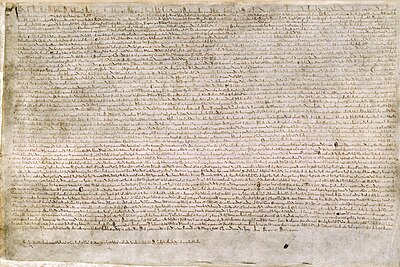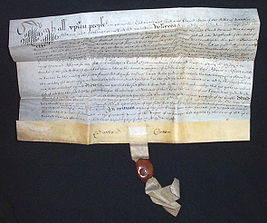1758 ***VERY RARE*** ~FRENCH VELLUM DOCUMENT~ ""GENUINE"" (2 PAGES) HAND-WRITTEN ON "ANIMAL SKIN" MANUSCRIPT WITH STAMPED SEAL!
(Approximate dimensions: 9 1/4" x 7").
((Please note: Item will be folded to original folds for mailing)).
265 year old French document! Fewer and fewer to be found!
___________________________________________________________________________________________________________
Vellum is prepared animal skin or membrane, typically used as writing material. It is distinguished from parchment when it is made from calfskin, rather than that made from other animals,[1] or having a higher quality when it is not.[2][full citation needed] Vellum is prepared for writing and printing on and used for single pages, scrolls, codices, or books.
Modern scholars and experts use the general and potentially-confusing term "membrane" more often.[3][full citation needed][4][full citation needed] It may be very hard to determine the animal species involved (let alone its age) without going to a laboratory depending on the way of making the paper.[5] Thus the term avoids the distinction between vellum and parchment.[3][4]
Vellum is generally smooth and durable, but there are great variations in its texture which are affected by the way it is made and the quality of the skin. The making involves the cleaning, bleaching, stretching on a frame (a "herse"), and scraping of the skin with a crescent-shaped knife (a "lunarium" or "lunellum"). To create tension, the process goes back and forth between scraping, wetting and drying. Scratching the surface with pumice, and treating with lime or chalk to make it suitable for writing or printing ink can create a final look.[1]
Modern "paper vellum" is made of synthetic plant material, and gets its name from its similar usage and high quality. It is used for a variety of purposes including tracing, technical drawings, plans and blueprints.[6][full citation needed][7][8]
Terminology[edit]
The word "vellum" is borrowed from Old French vélin 'calfskin', derived in turn from the Latin word vitulinum 'made from calf'.[9]However, in Europe, from Roman times, the word was used for the best quality of prepared skin, regardless of the animal from which the hide was obtained. Calf, sheep, and goat were all commonly used, and other animals, including pig, deer, donkey, horse, or camel were used on occasion. The best quality, "uterine vellum",[10] was said to be made from the skins of stillborn or unborn animals, although the term was also applied to fine quality skins made from young animals.[3] However, there has long been much blurring of the boundaries between these terms. In 1519, William Horman could write in his Vulgaria: "That stouffe that we wrytte upon, and is made of beestis skynnes, is somtyme called parchement, somtyme velem, somtyme abortyve, somtyme membraan."[11] Writing in 1936, Lee Ustick explained that:
French sources, closer to the original etymology, tend to define velin as from calf only, while the British Standards Institution defines parchment as made from the split skin of several species, and vellum from the unsplit skin.[13] In the usage of modern practitioners of the artistic crafts of writing, illuminating, lettering, and bookbinding, "vellum" is normally reserved for calfskin, while any other skin is called "parchment".[14]
Manufacture[edit]
Vellum allows some light to pass through it. It is made from the skin of a young animal. The skin is washed with water and lime (Calcium hydroxide), then soaked in lime for several days to soften and remove the hair.[15] Once clear, the two sides of the skin are distinct: the body side and the hairy side. The "inside body side" of the skin is usually the lighter and more refined of the two. The hair follicles may be visible on the outer side, together with any scars from when the animal was alive. The membrane can also show the pattern of the animal's vein network called the "veining" of the sheet.[16]
The makers remove any remaining hair ("scudding") and dry the skin by attaching it to a frame (a "herse").[17] They attach the skin at points around the edge with cords and wrap the part next to these points around a pebble (a "pippin").[17] They then use a crescent shaped knife, (a "lunarium" or "lunellum"), to clean off any remaining hairs.
The makers thoroughly clean the skin and process it into sheets once it is completely dry. They can extract many sheets from the piece of skin. The number of sheets depends on the size of the skin and the required length and breath of each individual sheet. For example, the average calfskin could provide roughly three and a half medium sheets of writing material. The makers can double it when they fold the skin into two conjoined leaves, also known as a bifolium. Historians have found evidence of manuscripts where the scribe wrote down the medieval instructions now followed by modern membrane makers.[18]The makers rubbed them with a round, flat object ("pouncing") to ensure that the ink would adhere to the surface.[16] Even so, ink would gradually flake off of the membrane, especially if it was used in a scroll that was frequently rolled and unrolled.
Manuscripts[edit]
Preparing manuscripts[edit]
Once the vellum is prepared, traditionally a quire is formed of a group of several sheets. Raymond Clemens and Timothy Graham point out, in their Introduction to Manuscript Studies, that "the quire was the scribe's basic writing unit throughout the Middle Ages".[19] Guidelines are then made on the membrane. They note "'pricking' is the process of making holes in a sheet of parchment (or membrane) in preparation of its ruling. The lines were then made by ruling between the prick marks ...The process of entering ruled lines on the page to serve as a guide for entering text. Most manuscripts were ruled with horizontal lines that served as the baselines on which the text was entered and with vertical bounding lines that marked the boundaries of the columns".[20]
Usage[edit]
Most of the finer sort of medieval manuscripts, whether illuminated or not, were written on vellum. Some Gandharan Buddhist texts were written on vellum, and all Sifrei Torah (Hebrew: ספר תורה Sefer Torah; plural: ספרי תורה, Sifrei Torah) are written on kosher klaf or vellum.
A quarter of the 180 copy edition of Johannes Gutenberg's first Bible printed in 1455 with movable typewas also printed on vellum, presumably because his market expected this for a high-quality book. Paper was used for most book-printing, as it was cheaper and easier to process through a printing press and to bind.
The twelfth century Winchester Bible was printed on 250 calfskins, with a need of over 2,000 hides to be collected for the preparation and creation of the bible.
In art, vellum was used for paintings, especially if they needed to be sent long distances, before canvasbecame widely used in about 1500, and continued to be used for drawings, and watercolours. Old master prints were sometimes printed on vellum, especially for presentation copies, until at least the seventeenth century.
Limp vellum or limp-parchment bindings were used frequently in the 16th and 17th centuries, and were sometimes gilt but were also often not embellished. In later centuries vellum has been more commonly used like leather, that is, as the covering for stiff board bindings. Vellum can be stained virtually any color but seldom is, as a great part of its beauty and appeal rests in its faint grain and hair markings, as well as its warmth and simplicity.
Lasting in excess of 1,000 years—for example, Pastoral Care (Troyes, Bibliothèque Municipale, MS 504), dates from about 600 and is in excellent condition—animal vellum can be far more durable than paper. For this reason, many important documents are written on animal vellum, such as diplomas. Referring to a diploma as a "sheepskin" alludes to the time when diplomas were written on vellum made from animal hides.
___________________________________________________________________________________________________________
We strive to find rare and unusual vintage pieces to match up with your special collection.
Returns are readily accepted if the item(s) is the same as described. Item(s) must be in the exact condition as delivered. Buyer pays return shipping.
Items $30.00 or more will be shipped with tracking. Items $200.00 or more will be shipped with insurance.
Combined shipping discount for multiple purchases (Please wait for us to send invoice for 2 or more items).
Please feel free to contact us with any questions or concerns.
Be sure to check out our "ever changing" inventory of vintage postage stamps, covers, postal cards, billheads, letterheads, stock certificates, bank checks, railroad and steamship ephemera, Civil War ephemera, World War I ephemera, World War II ephemera, Korean War ephemera, Vietnam War ephemera, promissory notes, automotive ephemera, fraternity ephemera, circus ephemera, jeweler and pocket watch ephemera, sports ephemera, vintage matchbooks, military memorabilia, badges, medals, pins and ephemera, vintage coins, vintage worldwide banknotes, vintage tokens historical memorabilia and ephemera, vintage pens and pencils plus many other special items we can pass onto our customers.
Empire Stamp Company
INTERNATIONAL SHIPPING:USPS FIRST CLASS MAIL INTERNATIONAL/FIRST CLASS PACKAGE INTERNATIONAL SERVICE.
DELIVERY TIMES WILL VARY BY LOCATION FOR INTERNATIONAL BUYERS.




